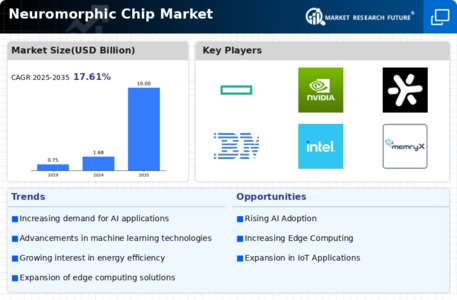Top Industry Leaders in the Neuromorphic Chip Market

The Competitive Landscape of the Neuromorphic Chip Market
The neuromorphic chip market, still in its nascent stage, is a breeding ground for innovation and disruption. Inspired by the human brain's architecture, these chips offer unique capabilities in tasks like image recognition, data processing, and even autonomous navigation. Naturally, this emerging field attracts a diverse set of players, each vying for a slice of the pie. Understanding the competitive landscape is crucial for anyone navigating this dynamic market.
Key Player:
- Hewlett Packard Enterprise
- Samsung Electronics Limited
- Intel Corp.
- HRL Laboratories
- LLC, General Vision Inc.
- Applied Brain Research, Inc.
- Brain chip Holdings Ltd.
- aiCTX AG, Qualcomm
- IBM
- Nepes Corp.
- Innatera
- MemComputing
- INSTAR Robotics
- Ceryx Medical
- Koniku
Strategies Adopted by Leaders:
- Leveraging existing semiconductor expertise: These giants leverage their established manufacturing capabilities and infrastructure to accelerate neuromorphic chip development.
- Internal R&D initiatives: Significant investments in research and development allow them to explore novel architectures and applications, strengthening their technological edge.
- Acquisitions and partnerships: Strategic acquisitions and collaborations with startups and research institutions expand their reach and expertise in specific areas.
Factors for Market Share Analysis:
- Technology Type: Different neuromorphic architectures, from spiking neural networks to memristors, cater to specific applications. Assessing dominant technologies within each segment paints a clearer picture.
- Application Focus: The market caters to diverse applications across healthcare, robotics, finance, and defense. Analyzing market share within each sector reveals the leading players and their areas of expertise.
- Development Stage: Neuromorphic chips are still evolving, with companies at different stages of development and commercialization. Identifying companies with robust R&D pipelines and early market traction becomes crucial.
- Partnerships and Collaborations: Strategic partnerships and collaborations can significantly impact market share. Tracking alliances between chipmakers, research institutions, and end-users provides insights into future market dynamics.
New and Emerging Companies:
- Agile and specialized solutions: Startups offer greater flexibility and agility in developing customized solutions for niche applications, catering to unmet market needs.
- Open-source platforms: Some startups advocate open-source hardware and software platforms, fostering collaboration and accelerating the development of the entire neuromorphic ecosystem.
- Cost-effective alternatives: By focusing on efficient chip design and novel materials, startups offer cost-competitive solutions, potentially driving wider adoption.
Latest Company Updates:
Hewlett Packard Enterprise (HPE)
- Oct 27, 2023: HPE partnered with Cerebras Systems to integrate their CS-1 neuromorphic supercomputer into its Cray EX supercomputing platform. This collaboration aims to provide researchers with access to unprecedented computing power for AI and deep learning applications.
- Dec 5, 2023: HPE announced plans to launch a Neuromorphic Computing Center of Excellence in collaboration with Stanford University and other partners. The center will focus on research and development of neuromorphic technology and its applications in areas like healthcare, materials science, and finance.
Samsung Electronics Limited
- Aug 25, 2023: Samsung unveiled its new "Odyssey" neuromorphic processor at the Hot Chips Symposium. Odyssey features a scalable architecture with 16,384 neuromorphic cores and offers improved energy efficiency compared to previous generations.
- Nov 15, 2023: Samsung announced a collaboration with the Korean Institute of Science and Technology (KIST) to develop neuromorphic chips for brain-inspired AI applications. The project will focus on creating artificial synapses and neurons that mimic the human brain's structure and function.
